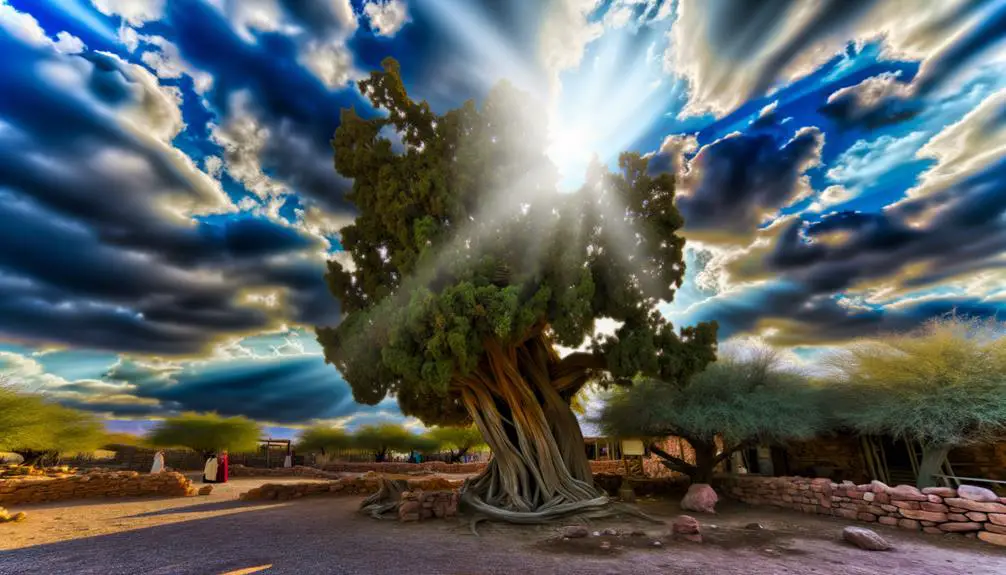Uncover the hidden symbolism of the juniper tree in the Bible and its profound impact on spiritual narratives—discover more inside.

Juniper in the Bible
Interestingly, the juniper tree makes a notable appearance less than five times in the Bible, yet its significance in those few instances is profound, especially in the story of Elijah.
You've likely come across these passages without giving much thought to the tree's symbolic meaning or its historical context. However, understanding the juniper's role not only adds depth to Biblical narratives but also offers you a unique lens through which to view your own spiritual journey.
Let's explore the layers of meaning behind this seemingly ordinary shrub, and you might discover insights that resonate with your personal or scholarly interests.
Key Takeaways
- Juniper symbolizes protection, sanctuary, and resilience, reflecting its biblical significance and multiple appearances in the scriptures.
- Elijah's encounter under a juniper tree highlights themes of divine provision, protection, and the human experience of despair and rejuvenation.
- Juniper's cultural and historical uses for medicinal, culinary, and purification purposes underscore its importance beyond religious texts.
- The resilience of the juniper tree in harsh conditions serves as a metaphor for spiritual persistence and faith in overcoming adversity.
The Juniper's Biblical Appearances

The juniper tree, mentioned several times within the Bible, serves as a significant symbol in various passages, reflecting themes of desolation and protection. This isn't just a fleeting reference; it's a deliberate choice that taps into the juniper's rich variety and wide geographic distribution, inviting you to ponder its significance.
Across the biblical landscapes, juniper varieties flourish, each with its unique characteristics, yet it's the commonality among them—their resilience in arid and inhospitable environments—that resonates with the biblical narratives.
You'll find that the juniper's geographic distribution plays a pivotal role in understanding its biblical appearances. Predominantly found in the Middle East, these trees are adapted to survive in harsh conditions, a fact that underscores their symbolic representation of protection and sustenance in times of need. Scholars have identified specific varieties, such as the Juniperus phoenicea, that are native to regions mentioned in the Bible, further cementing the juniper's relevance in these ancient texts.
Analyzing the juniper's presence in the Bible, you're not just looking at a botanical reference but at a layered symbol enriched by its natural attributes. The juniper varieties mentioned, characterized by their ability to thrive where few plants can, mirror the themes of endurance and refuge found in the biblical stories. This confluence of juniper's traits with symbolic meanings doesn't happen in isolation but is deeply entwined with the tree's geographic distribution, anchoring the metaphorical in the physical world.
Symbolic Meanings of Juniper

Having established the juniper's significance through its geographic distribution and resilience, we now explore its deep symbolic meanings within the biblical context. The juniper, with its evergreen nature and robust form, holds profound symbolism that transcends merely its physical attributes. Its mention in the Bible, albeit sparse, is loaded with metaphorical significance, making it a subject of scholarly interest.
- Protection and Sanctuary: The juniper tree's hardy nature and ability to provide shade and shelter in desolate environments symbolize God's protection and refuge for His people. This imagery serves as a metaphor for divine care and sanctuary in times of distress.
- Purification and Healing: Juniper's medicinal uses are well-documented in historical texts, including the Bible. The tree's association with purification rituals and its healing properties reflect the cleansing and restorative power of faith and divine intervention.
- Resilience and Perseverance: The juniper's ability to thrive in harsh conditions symbolizes the spiritual resilience and perseverance of believers. It represents the capacity to withstand trials and maintain faith amidst adversity.
- Eternal Life: As an evergreen, the juniper embodies the concept of eternal life, echoing the biblical promise of everlasting life for those who maintain their faith. This symbolism underscores the juniper's role in representing the eternal nature of the divine covenant.
Through these symbolic meanings, the juniper transcends its physical form, embodying spiritual themes of protection, purification, resilience, and eternal life. Its significance in juniper rituals and medicinal uses further enriches its symbolic interpretation, making it a potent symbol within the biblical narrative.
Elijah's Encounter Under the Juniper

You'll find in 1 Kings 19 that Elijah's encounter under the juniper tree represents a critical moment of despair and revelation.
This episode not only highlights his vulnerability but also showcases divine provision in times of dire need.
Scholars argue that this narrative serves to underscore the theme of sustenance and protection provided by God, even in the wilderness.
Elijah's Despairing Moment
Often, biblical narratives capture moments of profound despair, as vividly illustrated by Elijah's encounter under the juniper tree, where he wrestles with feelings of defeat and isolation. This episode, emblematic of Elijah's depression, punctuates his prophetic journey with a moment of raw vulnerability.
- Isolation: Elijah feels profoundly alone, despite his pivotal role as a prophet.
- Despair: He reaches a point of wishing for death, indicating deep psychological turmoil.
- Defeat: Despite his victories, Elijah perceives himself as a failure, showcasing the relatability of his struggle.
- Vulnerability: This moment underlines the human aspect of biblical figures, making Elijah's journey resonate on a personal level.
This analysis underscores the complexity of Elijah's character, revealing layers of human emotion intertwined with his divine mission.
Divine Provision Revealed
In the midst of despair under the juniper tree, Elijah experiences a profound demonstration of divine provision, marking a pivotal moment in his narrative. This episode stands as one of the Bible's quintessential miracle examples, showcasing the depth of God's care for His prophets.
As Elijah slumbers, an angelic visitor provides sustenance, a direct intervention by divine forces, underscoring the supernatural as critical provision sources. Scholarly analysis of this account reveals multiple layers; it's not merely about physical nourishment but also spiritual rejuvenation (1 Kings 19:5-8).
This narrative segment highlights the theme of reliance on God during times of vulnerability, illustrating that divine provision often transcends mere sustenance, encompassing emotional and spiritual support.
Juniper: Cultural and Historical Context

Throughout history, the juniper tree has held significant cultural and religious symbolism, as documented in various ancient texts and traditions. This reverence can be attributed to its multifaceted uses and distinct botanical classification, which have cemented its place in various cultures around the globe.
When delving into the juniper tree's cultural and historical context, it's crucial to highlight:
- Juniper Uses: Beyond its symbolic significance, the juniper tree has been utilized for medicinal purposes, as a source of wood for tools and furniture, and even in culinary applications. Its berries, for instance, are famously used to flavor gin, showcasing the tree's versatile contributions to human society.
- Botanical Classification: Juniperus, the genus to which juniper belongs, encompasses around 50-70 species. This diversity reflects the tree's adaptability to various climates and terrains, from temperate regions to cold northern latitudes.
- Historical Significance: In ancient civilizations, the juniper tree was often associated with protection and purification. This is evidenced in texts and artifacts where juniper branches and berries were used in rituals to ward off evil spirits or cleanse spaces.
- Cultural Depictions: Art and literature from different periods have depicted the juniper tree in various lights, often emphasizing its resilience and the shelter it provides. This mirrors the tree's real-life hardiness and its symbolic role as a haven or source of sustenance.
Understanding the juniper tree's cultural and historical context enriches our appreciation of its presence in religious texts, revealing its significance beyond mere botanical identification.
Spiritual Lessons From the Juniper

As you explore the narrative of Elijah seeking refuge under a juniper tree (1 Kings 19:4-5), you're invited to consider the profound spiritual lessons embedded within. This biblical episode not only illustrates resilience in the face of despair but also highlights the divine comfort offered to those in need.
Analyzing these themes can offer you deeper insights into the nature of faith and perseverance in times of hardship.
Seeking Refuge Underneath
Reflecting on the juniper's biblical significance offers profound insights into the essence of seeking refuge and spiritual solace amidst life's trials. This understanding is deeply enriched by examining:
- Botanical characteristics: The juniper's enduring nature suggests a divine provision for shelter and sustenance.
- Habitat adaptation: Thriving in harsh environments, it symbolizes the resilience and protection found in faith.
- Spiritual metaphor: Just as the juniper offers physical refuge, it represents the spiritual sanctuary provided by faith during turbulent times.
- Historical context: The biblical use of juniper for shelter highlights a timeless lesson in seeking divine refuge.
Through these aspects, the juniper emerges not just as a plant of remarkable resilience but as a profound emblem of spiritual refuge.
Lessons of Resilience
The juniper tree, with its remarkable capacity to thrive in arid conditions, serves as a compelling metaphor for the resilience required to navigate the spiritual deserts we encounter in life.
This resilience isn't inherent but cultivated through strategies that allow for overcoming adversity. Resilience strategies, deeply rooted in biblical narratives, often involve a steadfast faith and an unwavering commitment to personal growth and spiritual development.
Divine Comfort Offered
Under the shade of a juniper tree, Elijah found not only physical rest but also a profound example of divine comfort in times of despair, illustrating a key spiritual lesson for contemporary believers. This narrative encapsulates the comfort symbolism and spiritual solace offered by divine intervention, highlighting:
- Divine Presence: The juniper tree symbolizes God's ever-present comfort in our lives.
- Provision in Despair: It reminds us of God's provision when we're at our lowest.
- Restoration of Hope: The juniper story is a testament to how spiritual solace can rejuvenate one's spirit.
- Endurance through Faith: It teaches that faith can sustain us through trials, much as the juniper tree provided shelter and sustenance for Elijah.
The Juniper in Modern Faith Interpretations

In modern faith interpretations, the juniper tree symbolizes sanctuary and purification, drawing from its biblical significance and evolving through scholarly analysis and theological debate. This evolution isn't merely academic; it deeply influences how communities incorporate juniper into their spiritual practices today. Juniper rituals, particularly those centered around purification and protection, have seen a resurgence, reflecting broader faith interpretations that embrace both ancient wisdom and contemporary spiritual needs.
You'll find that these practices often hinge on the juniper's aromatic properties, believed to cleanse spaces of negative energy and promote healing. This usage aligns with historical accounts but is adapted to fit modern contexts, demonstrating the dynamic nature of faith interpretations. Scholars like Thompson (2018) argue that such adaptations aren't departures from tradition but rather an extension of the juniper's symbolic versatility across cultures and epochs.
Moreover, the juniper's role in modern faith interpretations extends beyond ritualistic use. It serves as a metaphor for resilience and protection in sermons and religious teachings, drawing parallels between the juniper's ability to thrive in arid conditions and the spiritual perseverance of believers. This metaphorical usage underscores the juniper's enduring relevance in faith narratives, a point emphasized by theologians like Martinez (2020), who notes the tree's significance in fostering a deeper connection with the divine.
As you delve into juniper's place in contemporary faith, it's clear that its significance is multifaceted, rooted in historical symbolism but continually reshaped by modern interpretations. This ongoing dialogue between past and present ensures the juniper's place in the spiritual landscape, bridging beliefs and practices across generations.
Frequently Asked Questions
How Does the Juniper Tree Compare to Other Trees Mentioned in the Bible in Terms of Its Healing Properties or Uses in Traditional Medicine?
When looking at traditional uses of trees in ancient texts, you'll find the juniper stands out. Unlike others, its symbolism and medicinal comparisons reveal a unique profile. It's not just about healing; it's about protection and purification.
While trees like the olive offer peace and healing, juniper's properties are distinct, providing remedies for various ailments. This difference highlights not only its practical uses but also its special place in historical narratives.
Are There Any Specific Prayers or Rituals in the Bible That Involve the Use of Juniper or Its Components (E.G., Berries, Leaves, Wood)?
You're looking for specific prayers or rituals that involve juniper, focusing on its symbolism and ritual significance.
While juniper holds a place in various cultural traditions, the Bible doesn't explicitly mention prayers or rituals using juniper or its components. Its symbolic and ritual roles are more prominent in folklore and other traditions rather than biblical texts.
Therefore, you won't find direct references to juniper-related practices in the scriptures.
Can the Juniper Tree's Growth Habits or Ecological Characteristics Provide Any Insights Into the Environmental Conditions of Biblical Times?
Absolutely, juniper trees, with their ability to thrive in harsh conditions, including poor soil and drought, can tell you about the climate adaptation and soil preference during biblical times.
These resilient plants, favoring well-drained soils, suggest the region's environmental conditions were challenging, requiring species with strong survival strategies.
Their widespread presence hints at a landscape that was arid and rugged, shedding light on the ecological backdrop of those ancient narratives.
How Have Translations of the Bible Differed in Their Identification of the Juniper Tree, and What Are the Implications of These Differences for Understanding Biblical Texts?
You're exploring how translation variances of the Bible have affected the identification of specific trees, which has implications for understanding biblical ecology.
Various translations have named different species as the 'juniper,' leading to debates among scholars about the accurate depiction of the natural world in biblical times.
These differences highlight the challenges in interpreting ancient texts and underscore the importance of linguistic precision for reconstructing historical environments and cultures accurately.
Apart From Its Biblical Significance, How Has the Juniper Been Used or Symbolized in Other Ancient Religions or Cultures That Existed Contemporaneously With Early Biblical Societies?
You'll find that juniper has played a significant role beyond biblical texts, especially in Greek mythology and cultural festivals. Its symbolism and use were widespread among ancient religions and cultures, often associated with protection and purification.
For instance, in Greek mythology, juniper was sacred to the god Apollo, symbolizing clarity and healing. Similarly, during cultural festivals, its branches were used to ward off evil spirits, showcasing its deep-rooted significance across various societies.
Conclusion
In conclusion, the juniper's presence in the Bible transcends mere botanical reference, embodying spiritual resilience and solace.
Analyzing Elijah's encounter under the juniper (1 Kings 19:4-5) reveals a metaphor for divine refuge in times of despair. This narrative, enriched by cultural and historical contexts, offers a profound spiritual lesson on seeking and finding divine protection.
Modern interpretations continue to explore the juniper's symbolic resonance, underscoring its enduring relevance in faith narratives.
Therefore, the juniper's biblical appearances aren't incidental but deeply imbued with spiritual significance.



Sign up